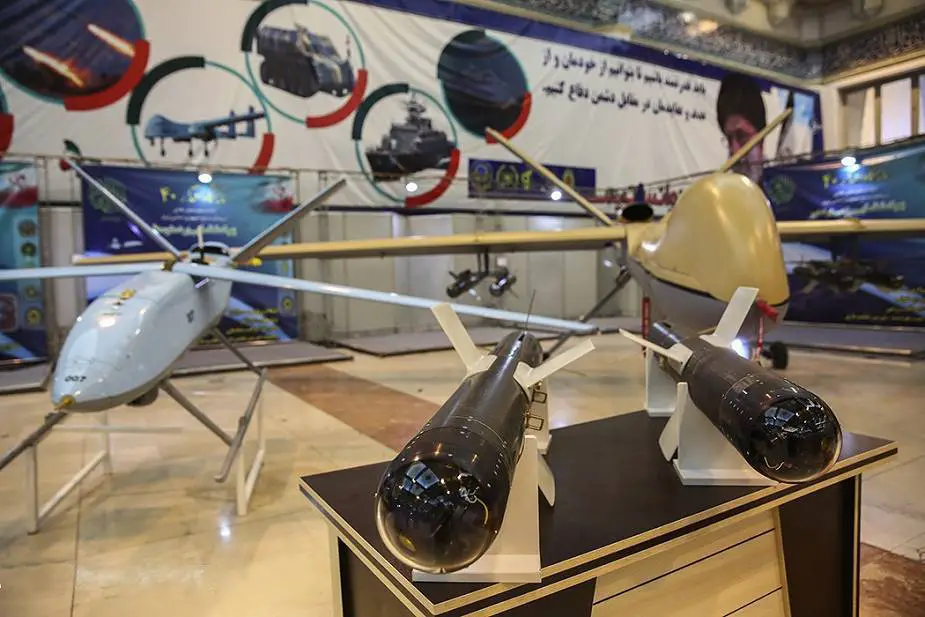In a military meeting held on June 23, 2023, Habibollah Sayyari, the Iranian Army Coordinator, expressed his satisfaction with the inauguration of the first strategic UAV base, as reported by the Tehran Times. The event marks a step in Iran's drone program and underscores the country's commitment to strengthening its defense capabilities.
Follow Army Recognition on Google News at this link

Iran has developed a wide range of military drones. (Picture source Wikimedia)
The newly inaugurated Unmanned Aerial Vehicle (UAV) base enhances Iran's capacity for surveillance and intelligence gathering. With the deployment of advanced drones, Iran aims to reinforce its strategic position in the region and bolster its defense capabilities.
Iran's drone program has made remarkable progress, resulting in the production of a diverse range of advanced drones. These unmanned aerial vehicles are utilized for various purposes, including surveillance, reconnaissance, and combat missions. Notably, Iran has developed a range of suicide drones with high accuracy and the ability to fly at low altitudes to evade radar detection.
The combat drone lineup of Iran includes over a dozen models equipped to engage ground, sea, and air adversaries before safely returning to base. Models such as the Shahed-149 have a range of 2,000 kilometers (1,240 miles) and can carry substantial munitions or electronic equipment.
Iran's drone capabilities extend to surveillance missions as well. These drones serve functions such as capturing photographs, recording videos, and marking targets for other aircraft. The country also operates smaller surveillance-only drones with limited range and endurance.
It is important to acknowledge that Iran's drone program has benefited from reverse engineering captured U.S. and Israeli drones, such as the Predator, Reaper, Sentinel, ScanEagle 5, and Hermes. By replicating the designs and importing certain U.S.-made parts, Iran has improved its less-advanced drones, including the Shahed-136.
In a notable development, the Shahed-136 has found usage in Ukraine, as reported by Army Recognition Group on May 4. The combined utilization of Russian Lancet drones and Iranian Shahed-136 drones by the Russian armed forces in Ukraine has intensified ground-based kamikaze strikes, posing significant challenges for Ukrainian defenses and escalating regional tensions.
Shahed-136
The Shahed-136 boasts impressive features in terms of design, flight capabilities, and combat use. With its delta-wing shape and stabilizing rudders, it measures 3.5m in length, has a wingspan of 2.5m, and weighs around 200kg.
Powered by a MADO MD-550 piston engine generating 50 horsepower, the drone can reach a maximum speed of 185km/h and has an estimated range of 1,000 to 2,500km, flying at altitudes ranging from 60 to 4,000 meters. Its payload includes a high explosive fragmentation warhead of 30-50kg, optics for precision attacks, and the option to equip photo equipment for capturing images and videos.
The Shahed-136 serves various combat purposes, such as anti-personnel and armored vehicle missions, anti-fortification operations, and radar seeker functions. It can be launched in salvo mode, forming a swarm of drones that can be programmed to carry out surveillance or attack tasks.
Additionally, it can be employed as a pre-programmed direct-attack munition or as a loitering munition with a radio signal range of approximately 150km, receiving new target location instructions via GNSS.
Iran has also showcased its drone capabilities through various operations, including strikes on Saudi oilfields, targeting dissident groups in neighboring countries, and providing support to proxy militias. The country has also exported drone technology to neighboring nations, expanding its influence in the region.
The establishment of a strategic UAV base in Iran reflects the country's attempts to enhance its defense capabilities and expand its presence in the region. The deployment of advanced drone technology signifies Iran's commitment to keeping pace with evolving security trends. While the establishment of the base raises important considerations for regional stability, it is an indication of Iran's pursuit of strategic interests .
















